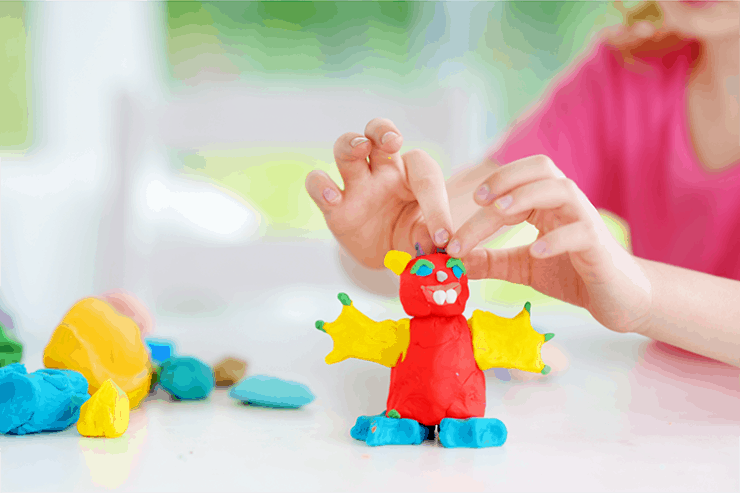During this time of uncertainty, grieving families may be experiencing heightened emotions or emotions that they thought had already been processed within their journeys. Anger can be a common emotion to feel during a time of distress and grief. Though anger is at times an uncomfortable emotion to experience, the expression of anger, when done through positive outlets, becomes a way for individuals to connect with themselves and process a difficult feeling. Anger can come from many different sources, but it is important to remember to express and process those feelings through healthy activities. Though everyone copes differently based on their personal needs, the following activities are helpful tools to process and learn more about self-regulation when angry.
Calm Down Bottle: Ages 3-8
Supplies: water bottle of any size, water, glue, glitter, food coloring (optional), Super Glue or hot glue for the cap
It can be difficult to regulate emotions, especially anger. Calm down bottles create a sense of regulation for children who need to take a few moments to self-regulate and breathe through their emotions. In order to create a calm down bottle, fill your child’s water bottle with 3/4th water. Allow your child to squeeze glitter glue (regular white or clear glue) into the bottle. If you do not have glitter glue, you may assist your child with sprinkling glitter directly into the bottle. Food coloring is optional to squeeze in, in order to change the color. If your art supplies are limited, your child may use sequins or a few beads in the bottle. After filling the bottle with the supplies, caregivers will close the lid with Super Glue or hot glue to ensure the bottle won’t spill. Once the bottle has been created your child may shake the bottle for a few moments, then put it on a flat surface and watch the glitter move up and down. The bottle movement allows the child to focus on a calming image while taking deep breaths. Encourage your child to take deep breaths through their nose and blow out through their mouths. This activity can be done as long as desired and as needed to help teach your child about self-regulation after feeling anger.
Play-Doh Anger Monster: Ages 9-12
Supplies: Play-Doh of any color, plate for the Play-Doh monster to be sculpted on, and various arts and crafts supplies such as pipe cleaners, googly eyes, beads, or yarn.
When a child shows symptoms of anger, it is important to teach them about positive and negative outlets for their anger in order to prevent harmful behavior to themselves or others. Allow your child to create a monster to represent their anger in that current moment based on the supplies on hand. This is your child’s opportunity to process the intensity of the anger through the creation of their monster. Once your child has created their monster, you can ask open-ended questions about their monster, such as asking what different parts of the monster’s features represent, how your child feels before and after creating the monster, etc. Open-ended questioning allows you to investigate your child’s feelings without assumption. After the monster has been created, your child has the opportunity to destroy it by hitting it with their fists. This can be a helpful form of releasing anger. If your child chooses to hit the monster and destroy it, check in and ask how your child is feeling after hitting the Play-Doh. This also gives your child a chance to self-reflect on the changes in their anger and how it felt to get some of those feelings out physically in a safe way.
Who or What Pushes your Buttons: Ages 13-18
Supplies: Any size or shape paper and a writing utensil
When grieving, anger can feel intensified or triggered by numerous sources. This activity allows teens to write out the source of their anger and process the feelings associated to why their anger has become triggered. The sources of anger can vary based on life experiences, comments of others, inability to do what teens would like to do, or feelings of grief. By having your teen write down the things that are bothersome, teens are able to identify their source of anger and begin processing what about the source has triggered them to feel as they do. After writing these down, teens can further process by evaluating how to manage their anger towards what they have written and what they can do to deescalate these sensations of anger. This will allow teens to gain a sense of insight and self-awareness surrounding feelings of anger.
Coping Skills List: Ages 19+
Supplies: Paper of any size and a writing utensil
When experiencing a variety of emotions while grieving, it is difficult to know what coping skill will be most helpful. Based on what has triggered your anger, coping skills that may work in regulating other feelings may not be the most helpful for anger. Try creating a list of attainable coping skills to do when feeling angry. This will allow you to have ideas of how to attempt to self-regulate before anger becomes out of control. When making the list of coping skills, think about what coping skills have worked in the past. What are some coping skills that are feasible to do? What are some you are willing to try? Coping skills can include self-regulation through relaxation, distraction, or confronting feelings. This list is unique to each person and is a helpful tool when emotions are heightened or there is a need to explore other de-escalation techniques. Some coping skills that could be of benefit are going out for a walk, taking deep calming breaths, getting outside in nature and focusing on grounding techniques, watching a funny tv show, calling a friend, or hitting a pillow.
Web of Connectedness: The Whole Family
Supplies: Ball or yarn/string/twine
Grieving can at times feel like an isolating place, especially when it comes to processing the emotions. The web of connectedness is an activity that can be done as a family in order to create unity and show others in the family that we all at times experience an array of feelings, including anger. Anger is an emotion that can have the connotation of “bad,” even though it is a normal feeling to have and express. In order to get connected, have all family members participating sit in a circle and take turns sharing something they have used to cope with anger and other emotions or something they have learned personally about their own feelings of anger and coping. Once the participant begins sharing, they will toss the yarn/string/twine to another family member across from them. This will continue until the yarn/string/twine has created a web, intertwining the family as a unit. If yarn/string/twine is not available, a ball can be tossed around the family circle to create the sense of unity. Anger can feel like an isolating and negative emotion, but when thoughts, feelings, and observations of growth are shared as a family about processing anger, the family can become more connected and understood.

